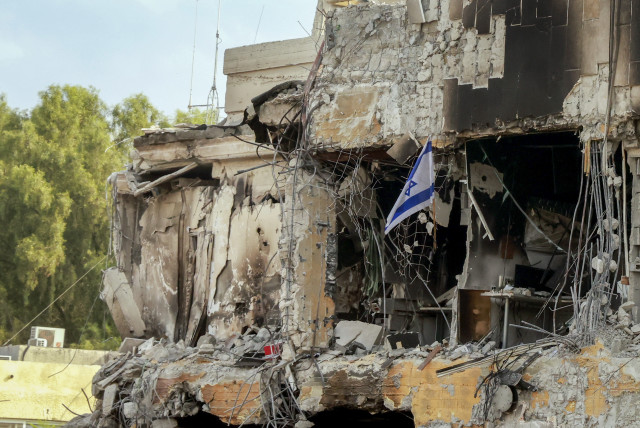Iran's shadow looms large in Israel-Hamas conflict

Amid rising casualties, new evidence points to Iranian involvement in Hamas’ surprise offensive against Israel.
The war between Israel and Hamas continues to take a heavy toll, as the number of casualties rises on both sides of the border. Over 1200 Israelis have been killed since the beginning of the war. Palestinian officials in the Gaza Strip report around 700 dead as a result of Israel’s retaliation.
As the dust settles on Hamas's surprise offensive, the tragedy is becoming clearer. Troubling questions about Israel’s lack of preparedness are also intensifying. Another question mark being raised relates to Iran’s involvement; the sophisticated and precise plan that the terrorist organization executed was likely supported by Israel’s archrival.
Citing senior Hamas members on Monday, The Wall Street Journal reported that the organization acknowledged Iranian help with the offensive, including receiving the go-ahead in a meeting held between representatives of both organizations last week.
For many years, Israel focused its efforts, both diplomatic and military, on thwarting Iranian nuclear aspirations, warning the world of a nuclear Iran.
“It’s about time that there is an understanding that the real and imminent Iranian threat looks exactly like this—the planning of the murder of Jews and Israelis,” Maj. (ret.) Alex Grinberg, a former Israeli military intelligence officer and an expert on Iran at the Jerusalem Institute for Strategy and Security, told The Media Line. “Iranians never take action on their own. They outsource with Shi’ite operatives.”
“It is clear the Hamas militants had very professional military training. In their first strike, they managed to neutralize all the observation and command posts along the border,” Grinberg added. “Only Iran and the Hezbollah in Lebanon could provide such training.”
On Saturday morning, Hamas launched an unprecedented attack against Israel. Storming the country’s southern border with Gaza, it instantly turned Israel’s multi-billion-dollar state-of-the-art fortified border into a porous opening that enabled Hamas terrorists to enter Israel and murder its citizens. In addition, Hamas's naval unit attempted to infiltrate from the coast, and Hamas parachuters descended on a massive outdoor rave being held adjacent to the border.
According to Grinberg, Hamas's hostile takeover of Israeli border communities was a move taken out of Hezbollah’s special forces textbook.
Iran's proxies against Israel
Hezbollah is a Shi’ite political and military organization that is the strongest armed force in Lebanon, and it is backed and financed by Iran.
Israeli defense officials have always maintained that Hamas's threat is incomparable in scope to the one from Hezbollah and Iran. However, the latest violence was a major show of force for Hamas.
“Iran likely helped in terms of upgrading Hamas's technologies and operational strategies to maximize the effects of its attacks. There are also telltale signs of Iranian strategizing, such as Hamas's swarming tactics through small units of guerrillas unleashing violence at many locations simultaneously,” Sean Yom, associate professor of political science at Temple University and a senior fellow at the Foreign Policy Research Institute, told The Media Line.
“But Iran neither led the campaign nor ordered it. As both the US and Israel have tentatively concluded, it seems to have been initiated and executed wholly by Hamas.”
In several interviews given Monday, US deputy national security adviser Jon Finer said that although the US believes Iran is “broadly complicit” in the Hamas attacks in Israel, it does not have “direct information” linking Iran to Hamas's attacks.
“Iran does not operate according to detailed, technical plans; they give a general order to their proxies and expect it to be executed,” said Grinberg.
Israel withdrew from the Gaza Strip in 2005, but since then has maintained a heavy military presence on the border. Gaza residents are accustomed to the hum of Israeli military drones constantly conducting surveillance missions. In response to Hamas's construction of cross-border attack tunnels, Israel has developed technological methods to trace those underground tunnels and then destroy them.
Throughout the years, Israel has conducted targeted killings, signifying its ubiquitous intelligence. In addition, Israel’s spy agency, the Mossad, is believed to be behind a series of assassinations that have been carried out from Dubai to Tehran, targeting senior figures of Iran’s nuclear program.
And yet, on Saturday, everything suddenly toppled all at once, and Israel was exposed to an unprecedented attack that was meticulously planned months in advance, under the nose of what is considered one of the strongest militaries in the world and an intelligence apparatus that prided itself on being omniscient.
Whether by funding Hamas for years or by aiding it with technology and know-how, Iran has been lurking in the background and may have even given Hamas the green light to begin an offensive that will reverberate throughout the entire Middle East.
Could this horrific attack bring Iran and Israel, two arch-rivals, closer to a direct confrontation, one they both have seemed determined to avoid?
“Supporting Hamas has long been a part of Iran’s regional ambitions to subvert a regional order headlined by American hegemony and its Arab alliances, and it mirrors its support for Hezbollah, the Yemeni Houthi movement, and Shi’a militias in Iraq—all of which, like Hamas, are nonstate actors,” Yom told The Media Line.
“But … Iran’s willingness to support such proxy actors is girded by the rational assumption that neither the US nor Israel, nor their Arab Gulf allies like Saudi Arabia and the United Arab Emirates, are willing to wage a full-scale battle against Tehran so long as Iran does not initiate a formal interstate war.”
In recent weeks, Israel has stepped up its rhetoric against Iran, increasing tensions between the arch-rivals who have been engaging in a shadow war.
Israeli officials have also increasingly pointed a finger toward Tehran, saying it was behind the recent escalation in terror activity in the West Bank. An uptick in attacks against Israelis there has been attributed not only to the Palestinian assailants who carried out the attacks but also to Iran.
Last month, Israel accused Iran of building an airport in neighboring southern Lebanon to be used as a launchpad for attacks against Israel. After weeks of tensions between Israel and Iranian-backed, Lebanon-based Hezbollah, it was another signal of a possible escalation. On Monday, there were several fire exchanges between Israel and Hezbollah, threatening to spill over into a wider conflict.
But no one saw this Hamas attack coming. No one thought the opening scene of the showdown between Israel and Iran’s proxies would be on the border with Gaza. Israeli media quoted unnamed defense officials who told the cabinet just days before the war began that Hamas was deterred by Israel and would not be initiating an offensive any time soon.
For over a year, there has been an increase in violence between Israelis and Palestinians in the West Bank. During most of this period, Hamas in Gaza has remained on the sidelines, with many defense experts believing it was not interested in an escalation with Israel, an escalation that would lead to major retaliatory destruction in the coastal enclave.
From Hamas and the Palestinian Islamic Jihad (PIJ) in Gaza and the West Bank to Hezbollah on Israel’s border with Lebanon, the terrorist organizations, all funded and supported by Iran, were waiting for the right time to pounce. Former Israeli Prime Minister Naftali Bennett had described Iran as the head of an octopus with far-reaching tentacles.
Israel captured the Gaza Strip and the West Bank territories during the 1967 Six-Day War. With the signing of the Oslo Accords 30 years ago, in 1993, a framework was established for Palestinian self-governance in parts of the West Bank and the Gaza Strip.
The subsequent Gaza-Jericho Agreement in 1994 led to Israel withdrawing its troops from most of the Gaza Strip, except for Jewish settlements and the surrounding areas. In 2005, Israel unilaterally withdrew its military and Israeli settlers from the entire Gaza Strip, handing it over to PA control. However, in 2007, Hamas violently took over and has since controlled the small strip of land while maintaining hostile relations with Israel, including initiating several wars.
As the current war carries on and Israeli military forces continue to battle terrorists who manage to infiltrate the border, Israelis in general are struggling to come to terms with the surprise offensive that caught an entire nation off-guard. The US, which also has intelligence capabilities in the region, was just as surprised.According to Yom, there is an overestimation of American intelligence capabilities.
“The nature of terrorism lies in its unpredictability, and that’s why the relative success and shock of terrorist attacks hinges upon their capacity to stun those who did not assume such brazen assaults against civilian populations could happen,” he said.
“The US and its partners know well that Hamas continually plans attacks against Israel, and that it draws financing and armaments from Iran, among other sources. The US also rightly assumed that since Israel has some of the world’s most sophisticated surveillance equipment and technologies of control, as well as anti-air defenses and high levels of military mobilization, any threat against Israel would not existentially imperil its statehood or political stability,” Yom added.
The Israeli government has vowed to crush Hamas. Whether it is successful or not, the Iranian threat will remain in other arenas.
Jerusalem Post Store
`; document.getElementById("linkPremium").innerHTML = cont; var divWithLink = document.getElementById("premium-link"); if (divWithLink !== null && divWithLink !== 'undefined') { divWithLink.style.border = "solid 1px #cb0f3e"; divWithLink.style.textAlign = "center"; divWithLink.style.marginBottom = "15px"; divWithLink.style.marginTop = "15px"; divWithLink.style.width = "100%"; divWithLink.style.backgroundColor = "#122952"; divWithLink.style.color = "#ffffff"; divWithLink.style.lineHeight = "1.5"; } } (function (v, i) { });

